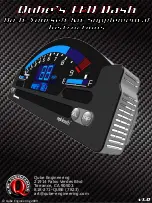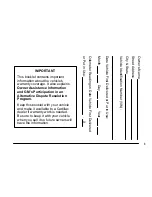
STARTING AND OPERATING
221
(Continued)
crossing deep water unless you ingested water
into the engine air intake. If the engine stalls, do
not attempt to restart it. Determine if it has
ingested water first. The key to any crossing is
low and slow. Shift into first gear (manual
transmission), or DRIVE (automatic
transmission), with the transfer case in the 4L
position and proceed very slowly with a
constant slow speed (3 to 5
mph {5 to 8
km/h}
maximum) and light throttle. Keep the vehicle
moving; do not try to accelerate through the
crossing. After crossing any water higher than
the bottom of the axle differentials, you should
inspect all of the vehicle fluids for signs of water
ingestion.
Before You Cross Any Type Of Water
As you approach any type of water, you need to
determine if you can cross it safely and
responsibly. If necessary, get out and walk
through the water or probe it with a stick. You
need to be sure of its depth, approach angle,
current and bottom condition. Be careful of
murky or muddy waters; check for hidden
obstacles. Make sure you will not be intruding
on any wildlife, and you can recover the vehicle
if necessary. The key to a safe crossing is the
water depth, current and bottom conditions. On
soft bottoms, the vehicle will sink in, effectively
increasing the water level on the vehicle. Be
sure to consider this when determining the
depth and the ability to safely cross.
Crossing Puddles, Pools, Flooded Areas Or
Other Standing Water
Puddles, pools, flooded or other standing water
areas normally contain murky or muddy waters.
These water types normally contain hidden
obstacles and make it difficult to determine an
accurate water depth, approach angle, and
bottom condition. Murky or muddy water holes
are where you want to hook up tow straps prior
to entering. This makes for a faster, cleaner and
easier vehicle recovery. If you are able to
determine you can safely cross, than proceed
using the low and slow method.
Crossing Ditches, Streams, Shallow Rivers Or
Other Flowing Water
Flowing water can be extremely dangerous.
Never attempt to cross a fast running stream or
river even in shallow water. Fast moving water
can easily push your vehicle downstream,
sweeping it out of control. Even in very shallow
water, a high current can still wash the dirt out
CAUTION!
Water ingestion into the axles, transmis
-
sion, transfer case, engine or vehicle inte
-
rior can occur if you drive too fast or
through too deep of water. Water can cause
permanent damage to engine, driveline or
other vehicle components, and your brakes
will be less effective once wet and/or
muddy.
When driving through water, do not exceed
5
mph (8
km/h). Always check water depth
before entering as a precaution, and check
all fluids afterward. Driving through water
may cause damage that may not be
covered by the New Vehicle Limited
Warranty.
CAUTION!
Muddy waters can reduce the cooling system
effectiveness by depositing debris onto the
radiator.
4
CAUTION!
(Continued)
Содержание Gladiator 2021
Страница 94: ...92 GETTING TO KNOW YOUR VEHICLE Hard Top Components 1 Right Side Panel 2 Left Side Panel 3 Hard Top ...
Страница 112: ...110 GETTING TO KNOW YOUR INSTRUMENT PANEL INSTRUMENT CLUSTER Base Instrument Cluster Gasoline ...
Страница 113: ...GETTING TO KNOW YOUR INSTRUMENT PANEL 111 Premium Instrument Cluster Gasoline 3 ...
Страница 114: ...112 GETTING TO KNOW YOUR INSTRUMENT PANEL Base Instrument Cluster Diesel ...
Страница 115: ...GETTING TO KNOW YOUR INSTRUMENT PANEL 113 Premium Instrument Cluster Diesel 3 ...
Страница 482: ......
















































